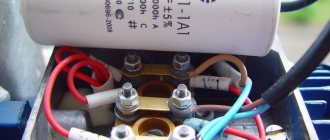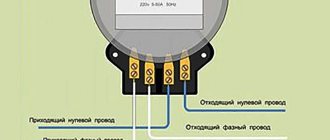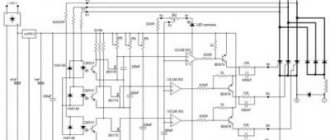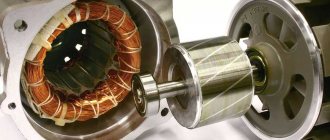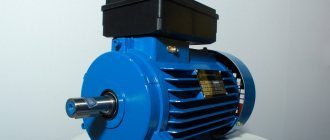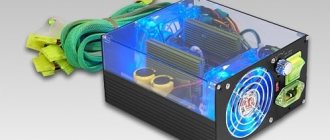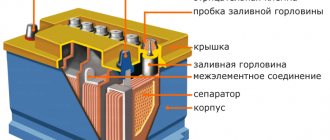Almost everyone is well aware of three-phase electric motors; they are widely used in industry and allow solving a wide variety of problems. And we are accustomed to consider the principle of obtaining alternating current as a physical quantity using the example of the same three-phase asynchronous generators. But what to do in domestic conditions, where there is only one phase? Craftsmen have learned how to connect three-phase electrical machines, but this is not necessary. In practice, a single-phase asynchronous electric motor has long been used, which can perform all its functions even in a home AC network.
Design features
If we compare a single-phase electric motor with other electric machines, then structurally it also consists of a movable and stationary element - a stator and a rotor. The stator, due to the flow of electric current through its windings, creates a magnetic field that interacts with the rotor. As a result of electromagnetic interaction, the rotor is rotated.
Rice. 1. Design of single-phase asynchronous electric motor
However, everything is not as simple as it might seem at first glance; if you removed the extra two windings from a conventional three-phase electric motor and plugged it into an outlet, rotation would not start. The motor simply does not have enough torque to rotate the rotor. Therefore, the design of a single-phase asynchronous electric motor has a number of features.
Rotor
The rotor of a single-phase electric motor is the same metal shaft, which is equipped with a winding. A ferromagnetic frame made of laminated steel is assembled on the shaft and grooves are made along its outer surface. Rods made of copper or aluminum are installed in the grooves on the rotor shaft, which act as a winding that conducts electric current. At the ends, the rods are connected by two rings, due to this design it is also called a squirrel cage.
When an electromagnetic flux from the stator is applied to the short-circuited windings of the rotor, current begins to flow in the squirrel cage. A ferromagnetic insert on the shaft helps to enhance the flux passing through it. However, not all models have a magnetic conductor; in some it is made of non-magnetic alloys.
Stator
The stator design in a single-phase electric motor has the same composition as in most electrical machines:
- metal case;
- a magnetic circuit made of ferromagnetic material installed inside;
- stator winding, represented by copper conductors.
The stator windings of such an electric motor are divided into two - the main winding, which is also the working winding, through which the load is constantly circulated, and the starting winding, which is activated only at the time of start-up. Both windings of a single-phase motor are located at an angle of 90° relative to each other. This design makes them similar to two-phase electric motors, which also use two windings.
But their volume, relative to the entire space of the asynchronous motor, is different; the main one is only 2/3 of the total number of slots, and the starting windings occupy 1/3.
General information about single-phase electric motors
A household electric motor is a single-phase motor, which, by mistake, is often called a “two-phase electric motor”, because it is used in a network with a voltage of 220V. In this regard, a single-phase motor is called a 220 electric motor or a 220V motor. Electric motors of the AIRE series (single-phase motors - “household electric motors”) are asynchronous single-phase with a squirrel-cage capacitor rotor and are designed to operate from an alternating current network with a voltage of 220 V and a frequency of 50 Hz. Operation from a mains voltage of 230 V with a frequency of 50 Hz and 220, 230 V with a frequency of 60 Hz is allowed. The single-phase 220V motor is made with a two-phase winding on the stator (“two-phase motor”). To reduce the influence of ambient temperature on the capacitance of capacitors, they should be placed in places least susceptible to temperature fluctuations. During engine operation, it is recommended to periodically monitor the capacitance value of the capacitor.
Operating conditions for a single-phase 220V motor
- Voltage and frequency: 220V at a frequency of 50 Hz.
- Type of climatic modification: U2, U3, U5, UHL,2, T2.
- Operating mode: S1.
- Degree of protection for the basic version: IP 54.
- Cooling degree - IC 041.
- Heat resistance class of insulation: electric motors are manufactured with insulation of heat resistance class “B” or “F” according to GOST 8865-93.
- Nominal values of climatic factors according to GOST 15150-69 and GOST 15543.1-89.
- Air dust content is no more than 2 mg/m3.
- Mechanical design group M1 according to GOST 17516.1-90.
- Impact of vibration loads for engines corresponding to degree 1 of rigidity according to GOST 17516.1-90.
Principle of operation
The operating principle of a single-phase asynchronous electric motor is to create a pulsating magnetic flux from the flow of electric current through the main stator winding, if we consider the option of starting from an auxiliary turn. Thus, we will consider connecting a single-phase motor to the network using the example of one turn.
Rice. 2. The principle of magnetic flux formation in the stator
As you can see in the figure above, alternating electric current, flowing through a conductor, according to the gimlet rule, creates concentric magnetic fluxes. When the maximum of the sinusoid appears, the magnetic flux will also reach its maximum. However, in a single-phase alternating voltage network, the current changes its direction of movement in a coil with a frequency of 50 Hz. This means that as soon as the curve crosses the x-axis, the current will flow through the winding in the opposite direction and the magnetic flux created by it will receive opposite poles and the direction of the resulting vector:
Rice. 3. Formation of reverse flow
From a physical point of view, both flows are equivalent, so changing them at intervals of 100 times per second will give a zero result when added. The forward magnetic flux will be equal to the reverse one:
Fpr = Fobr
This means that if the rotor of an electric motor is in such a field, it will not rotate. The magnetic flux will change 100 times a minute, and the squirrel-cage rotor will simply hum, remaining in place. However, the situation will change radically if there is an impulse to the initial movement. In this case, slipping will appear, which will lead to constant rotation of the shaft:
Spr = (n1 - n2) / n1, where
- n1 – rotation frequency of the magnetic field of a single-phase electric motor;
- n2 – rotor speed of the asynchronous electric motor;
- S is the slip value of a single-phase induction motor.
When the magnetic flux changes, the direction of rotation and the fields of the stator and rotor of the electric motor will coincide, so the slip will receive a different expression for calculation:
Sobr = (n1 - ( - n2)) / n1, where
The alternating intersection of the rods with magnetic fluxes of different directions will create an EMF in them, which will generate an electric current in the rotor and a response magnetic flux. And it, in turn, will also interact with the stator field of a single-phase electric motor, as shown in the figure below.
Rice. 4. Obtaining EMF in the rotor
As you can see, to connect a three-phase electric motor, you just need to apply voltage to it, but this option will not work with a single-phase one.
To start the motor, a primary impulse is required, which in practice can be obtained by:
- spinning the shaft manually;
- short-term introduction of the trigger coil;
- splitting of the magnetic field by a short-circuited circuit.
Of the above methods, today the first is used only in laboratory experiments; it has fallen out of practical use due to the risk of injury to the operator.
Switching to the desired voltage
First we need to make sure that our engine has the necessary parameters. They are written on a tag attached to his side. It should indicate that one of the parameters is 220V. Next, let's look at the connection of the windings. It is worth remembering this pattern of the circuit: star - for lower voltage, triangle - for higher voltage. What does this mean?
Voltage increase
Let's say the tag says: Δ/Ỵ220/380. This means that we need a delta connection, since most often the default connection is 380 volts. How to do it? If the electric motor in the burner has a terminal box, then it is not difficult. There are jumpers there, and all you need to do is switch them to the desired position.
But what if there are just three wires? Then you will have to disassemble the device. On the stator you need to find three ends that are soldered together. This is a star connection. The wires need to be disconnected and connected in a triangle.
In this situation this does not cause any difficulties. The main thing to remember is that there is a beginning and an end to the coils. For example, let’s take as a starting point the ends that were brought out into the boron of the electric motor. This means that what is soldered is the ends. Now it’s important not to get confused.
We connect like this: we connect the beginning of one coil to the end of the other, and so on.
As you can see, the scheme is simple. Now the engine, which was connected for 380, can be connected to a 220 volt network.
Voltage reduction
Let's say the tag says: Δ/Ỵ 127/220. This means a star connection is required. Again, if there is a terminal box, then everything is fine. What if not, and our electric motor is turned on in a triangle? And if the ends are not signed, then how to connect them correctly? After all, here it is also important to know where the coil winding begins and where the end is. There are some ways to solve this problem.
First, let's move all six ends apart and use an ohmmeter to find the stator coils themselves.
Let's take adhesive tape, duct tape, whatever else we have, and mark them. It will come in handy now, and maybe someday in the future.
We take a regular battery and connect it to ends a1-a2. We connect an ohmmeter to the other two ends (c1-c2).
At the moment the contact with the battery is broken, the arrow of the device will swing to one side. Let's remember where it swung and turn on the device to ends c1-c2, without changing the polarity of the battery. Let's do it all over again.
If the arrow deviates in the other direction, then we swap the wires: we mark c1 as c2, and c2 as c1. The point is that the deviation is the same.
Now we connect the battery, observing polarity, to ends c1-c2, and the ohmmeter to a1-a2.
We ensure that the needle deflection on any reel is the same. Let's double check again. Now one bundle of wires (for example, with the number 1) will be the beginning, and the other will be the end.
We take three ends, for example, a2, b2, c2, and connect them together and isolate them. This will be a star connection. As an option, we can output them directly to the terminal block and label them. We paste the connection diagram onto the lid (or draw it with a marker).
Switching triangle - star done. You can connect to the network and work.
Connection diagrams
To obtain the basic rotational impulse, various connection schemes can be used. Over time, some of them lost their relevance and were replaced by more progressive ones, so next we will look at the most effective ones, which are still used today.
With starting resistance
Since the resistance of the windings in induction motors has a complex form, the magnetic flux vector can be easily shifted if resistance is added to the starting winding. The presence of an active component will give the required shift angle between the working coils of a single-phase electric motor and the starting coil, from 15° to 50°, which will provide the difference for the initial rotation.
Rice. 5. Circuit with starting resistance
With capacitor start
Unlike the previous method, in a circuit with a capacitor start of an electric motor, a capacitive element is used, which allows you to shift the electrical quantities in the main and starting coils by 90°, providing maximum force.
Rice. 6. Capacitor start circuit
In practice, the starting capacitor along with the additional winding is introduced by the start button simultaneously with the supply of the main power. The start button is designed in such a way that contact Cn is returned by a spring to its original position immediately after the end of the capacitor start.
Split pole
Unlike capacitor motors, this starting method requires the presence of a special design of the stator magnetic circuit. In this case, each pole is divided into two, one of which is equipped with a short-circuited coil that changes the characteristics of the magnetic flux.
Rice. 7. Shaded pole circuit
A significant disadvantage of this method of starting a single-phase electric motor is the constant loss of power and a decrease in the efficiency of the motor. Therefore, it is used only in electric machines up to 100 kW.
Varieties by number of phases
Depending on the design and connection method, short-circuited structures are divided into 3 types, each of which has its own characteristics:
- Single-phase. A single working winding is used. Starting is carried out by means of an inductor, connected for a short period to the network through a capacitor. A short circuit is also a possibility. The design is designed for low power, and is widely used in household appliances.
- Two-phase. The stator design uses 2 windings located perpendicular to each other. In this case, alternating voltage is supplied to each of them. The main area of application is single-phase networks. For correct operation in such conditions, only one of the windings is connected directly to the phase. The second is powered by a phase-shifting capacitor. This element is mandatory, since without adding it to the circuit, the rotation of the shaft will not begin. Due to this feature, two-phase asynchronous motors are sometimes called capacitor motors.
- Three-phase. The design involves 3 windings. They can be produced with different starting systems, but in any design they are characterized by increased stability of operation at rated load. They have the highest starting characteristics.
The number and location of windings are chosen depending on the type of network and the level of loads that will fall on the motor.
Application area
Single-phase electric motors are widely used in household appliances or industrial small-scale mechanization devices. They cover relatively low-power single-phase equipment that is powered by 220V.
These are various machines for processing wood, metal, plastic, etc. Single-phase electric motors are also used in agricultural installations for mixing grains, making concrete, etc. In everyday life, they are used in some models of microwave ovens, hoods, washing machines and coolers powered by a single-phase source.
Launch rules
There will be no problems in this aspect. These devices are installed on almost all types of household devices, so a standard household outlet is sufficient. Regardless of what type of electric motor is used, alternating current is always needed. If a low-speed electric motor is used, then other types of energy sources can be used. There are two main types of launch systems:
- Starting is carried out due to additional winding. After the rotor reaches the required speed, it simply turns off and only the main winding works.
- In the second case, a capacitor is used, which is connected to an additional winding. This system works constantly.
All types of 220 V single-phase electric motors considered are interchangeable. That is, the same type of motor is installed on a refrigerator, washing machine, lawn mower, and so on. Currently, during repairs and maintenance, basic safety rules must be observed. In case of any insulation failure, the insulating tape should be replaced with the device turned off.
